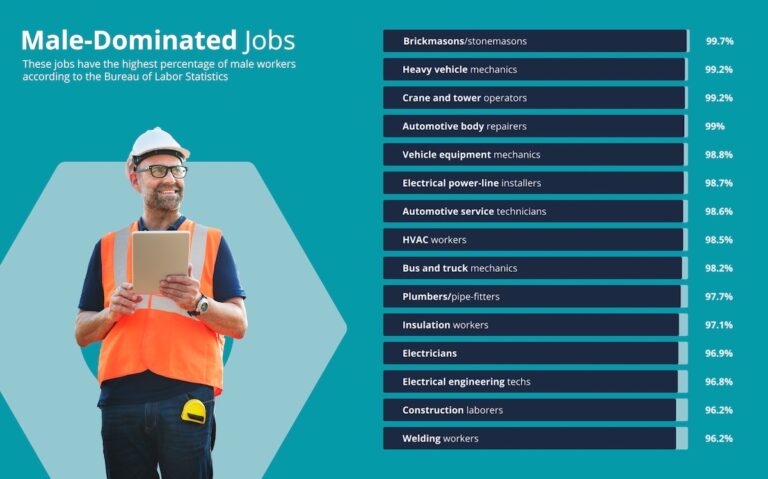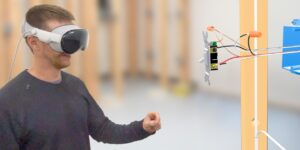The US is in the midst of a skilled labor crisis. Nearly four years after the beginning of the COVID-19 pandemic, Federal Reserve Chairman Jerome Powell says there is a “structural labor shortage” with at least 3.5 million workers “missing” from the workforce.
Male Workers are MIA
Political economist Nicholas Eberstadt puts that number much higher, among working-age males alone. He says more than seven million men in their prime, between 25 and 54, are “not participating” in the labor force at all. According to the Bureau of Labor Statistics, in 1953, 98% of men in that age range either had a job or were looking for one. That number has declined steadily now equaling the share of American men out of work “as large as it was during the Great Depression.” At the same time, there are 9.8 million job openings according to the US Chamber of Commerce.

The Trades Deficit
The trades are especially affected because they are overwhelmingly dominated by male workers. The crisis is compounded by the inevitable retirement of a generation of locksmiths, welders, plumbers, and electricians. More than half of the 76 million boomers are already over age 65. The pandemic accelerated their departure from the workforce because older workers were at a greater health risk. Many never returned.
The US Bureau of Labor Statistics (BLS) reports a deficit of almost 1.5 million workers in the trades, transportation and utilities. For example, the National Electrical Contractors Association (NECA), states approximately 50,000 electricians retired over the past five years; but only 35,000 new electricians were hired to replace them. At the same time, the BLS projects a sharp increase in electrical demand over the next decade which will create more than 73,000 open electrician jobs each year. Those positions will be filled by younger workers.

Gen Z has Great Expectations
Generation Z, the 60 million people born between 1997 and 2012, came of age in a digital world; on average, they received their first mobile phone just after their tenth birthday. Research by Dell indicates 80% of this age group aspire “to work with cutting-edge technology” and will make up 30% of the labor force by 2030. When it comes to employment, 91% say tech would influence job choice among similar offers. They enter the workforce with less mechanical experience than the generations before them, and with less exposure to opportunities in skilled labor since many public schools stopped offering shop classes.
“It goes back to the stigmas and stereotypes, myths and misperceptions that are keeping guidance counselors from talking about opportunities [in the trades] to the kids in their care,” says “Dirty Jobs” Host Mike Rowe. He says parents often push their kids to go to college, even if they did not. The result? About 62% of high school students enroll directly into college, but the financial return from a bachelor’s degree is softening, even as tuition debt soars. Nationwide, 30% of college students haven’t earned a degree within six years.
How Zoomers Want to Learn
Gen Z is comfortable and competent on mobile devices; they a are accustomed to instant access to information. They are less receptive than millennials (those born between 1981 and 1996) to classroom-style or book learning. They prefer visual instruction (images and video) as opposed to text-dense resources.
Researchers identify Gen Z learning preferences as on-demand, self-directed, customized, and independent. While expecting autonomy from authority, they also value collaboration and crowdsourcing. As digital natives, Gen Z’s online community is more international and inclusive than previous generations; and they are the most diverse employee group yet.
Zoomers prefer microlearning that delivers content in small, bite-sized pieces. They are digital natives accustomed to content flowing from multiple screens. Despite this, only one in five learning and development professionals plan to offer self-directed training to Gen Z workers in the future.
Tech Tools for the Next Generation
Forward-thinking companies are innovating training with technology. For construction job training, 70% of learning is experiential as opposed to 10% classroom work. Deploying technology to standardize processes can reduce upskilling time and callbacks, increase safety, and improve both job satisfaction and outcomes. Technology can also reduce costs and damage to equipment compared to traditional on-the-job training.
There is a wide range of options, hardware, and costs associated with immersive learning technologies. Virtual reality (VR) requires a headset and content creation is relatively expensive. Airbus, Air France, and KLM collaborated to create VR training for workers maintaining aircraft engines. Porsche leverages VR technology in training 8,000 technicians working in service centers worldwide. Henkel Loctite also uses VR for vehicle training to make repairs faster, safer, and more reliable.
Augmented reality (AR) is less expensive and can be experienced with or without a headset. It requires a strong internet connection. Boeing technicians used AR on Google Glass to guide technicians through installation and maintenance of aircraft, significantly reducing time on task. BAE Systems has been working with AR for more than seven decades, advancing from helmets to glasses to impose computer-generated data over the real world. Arkema uses AR delivered to a tablet or HoloLens to guide inspectors through quality control of boiler making equipment.
Tesla, ASSA ABLOY, the U.S. Air Force, and Siemens Smart Infrastructure deliver immersive training to field service technicians’ mobile devices via the 3D interactive BILT app. These digital work instructions provide intuitive guidance at a lower cost than AR and VR and require neither a headset nor an internet connection for mobile devices, but will be available on Apple Vision Pro in 2024.

Besides job security and competitive salaries, the next generation of tradespeople, skilled workers, and field service technicians want to work for companies that provide training and upskilling with the latest technology.



